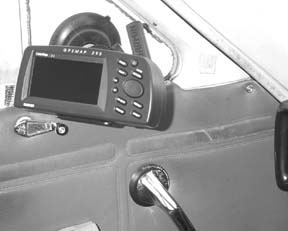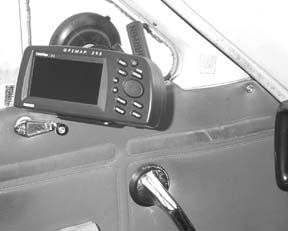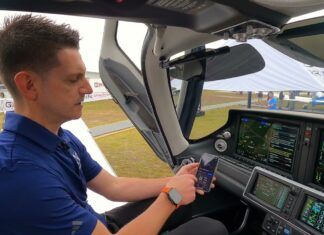
by Jonathan Spencer
The collection of stuff-electronic or otherwise-that can be mounted in an airplane cockpit has increased exponentially. These days, even airplanes with panel-mounted GPS often sport a handheld, either for back-up or as an alternate source of nav data. Then there are handheld radios, PDAs, cellphones, even laptop computers. The problem: how you mount all these gadgets so theyll stay put?
Most manufacturers mounts are compromises meant to work for everyone but that end up working for no one. Often, the mount is clunky, awkward and hard to use or it blocks critical instruments. A company called RAM rides to the rescue. If youve seen this companys booth at OSH or AOPA Expo, you know that they make a bewildering variety of hardware to mount cockpit accessories. In fact, the biggest challenge with RAM mounts may be navigating your way through their enormous selection to find the mount you need. Their online library-which they caution is incomplete-has 370 components spread across 19 Web pages. Or you can download a PDF-format catalog with extensive examples of how to combine the components, but its also incomplete.
To sort through the clutter, we recently obtained a generous sampling of RAM components and tested them out in a Cardinal and a Robinson helicopter. We also compared them to the standard accessory mounts most manufacturers provide with their products, thus we’ll make some recommendations based on experience.
The Ball
It helps to understand that a RAM mount is not a single component but a group of components assembled so as to hold some device at one end and attach to some part of a vehicle at the other. When we first covered this topic in the June, 1999 issue of Aviation Consumer, we suggested a think-erector-set approach to the RAM product line and thats still the best way to make sense of it all.
The universal component in virtually all the RAM mounts is a hard rubber ball on a metal core (see photo at right) that forms half of a ball-and-socket joint. The design of the ball ensures that when properly clamped, it holds firmly yet damps vibration.
RAM makes four sizes of balls (9/16 inch, 1 inch, 1 1/2 inch and 2 1/4 inch), but almost all aviation components are based on the 1-inch ball. This is the basis for eliminating a good part of the catalog. When shopping, look for the B-suffix that indicates a component is made for the 1-inch ball. For example, the basic surface mount with a 1-inch ball is a RAM-B-202.
A word of caution here: RAMs catalog numbering system is confusing. Components using the four ball sizes use sequential nomenclature-A, B, C and D, respectively-to signify the ball size. All include their suffix in their catalog number except for components using C-size balls, which, for some reason, have no suffix. This explanation of the catalog numbering system makes the online component library easier to understand. But the only place we found it is on page 3 of the downloadable PDF catalog; we couldnt find it on the Web site.
The other universal component is a double socket arm that grasps a ball at each end in a clamshell-like opening, forming the socket of the ball-and-socket joint. The arms are made in sizes to match the four ball sizes and in different lengths. A stainless steel screw in the double socket arm tightens it onto both balls.
One clever feature is a spring in one end of the arm. When the screw is loosened a bit, the spring forces the other end of the arm to stay closed. To put a ball in that end, grasp the arm at the spring end and squeeze. Put the ball in the socket and relax your grip. The arm grasps the ball firmly enough to stabilize it while you add a component at the other end.
Everything else in the product line springs from the ball-and-socket concept. The other components consist of device holders for a wide variety of (mostly electronic) devices, surface mounts and various types of extensions between joints.
Device Holder
You design your particular mount by first finding a device holder. These vary widely and a little research may be required to find the best one for what youre mounting. Some are standalone device-specific components, such as the GA2 for the Garmin II, III, and V-series, which is a molded plastic holder that fits snugly around the Garmin unit.
Others take advantage of portions of the manufacturers mounts, such as the GA1 for the Garmin 195, 295 and Street Pilot III, which is a ball mounted on a simple disk with multiple screw holes that match the holes on the Garmin mount. One interesting device holder recently added to the line is a powered docking cradle for iPAQ handhelds. This includes both a power and a serial connection for the iPAQ. And if your device of preference is a can of soda, RAM can accommodate that, too.
If you have a new device, it may not have a RAM holder yet, but it probably will before long. RAM offers to design a custom mount for any manufacturer interested in paying for it. Based on the wide assortment of mounts available, most have decided its worth the investment. The good news is that if you have an unusual mounting situation, you can find a RAM clamp to fit it.
Surface mounts also come in many flavors. If youre willing to drill holes in the mounting surface, RAM will sell you a ball on a disk with screw holes. Drill matching holes, drive the screws and then assemble the rest of the mount from there. There’s also the requisite control-column clamp, which fits most yoke-equipped aircraft. For Beech aircraft with throw-over yokes, there’s a mount with adjustable hose clamps and includes a protective rubber pad.
Our favorite, and one of the more flexible surface mounts, is a large suction cup which will go about anywhere. In our tests, this worked quite well, even on curved sections of Plexiglas. At first, we were concerned that it would pop loose after a few minutes, but our fears were unfounded. Quite the opposite, we found that the little tab RAM considerately puts on the edge of the suction cup to help in removal was not a luxury but a necessity.
Finally, there are the special-purpose components. One of the most interesting is a Cessna seat-rail mount that attaches across the two Cessna seat rails, providing a base upon which a number of devices can be mounted. RAM shows an example supporting a laptop, a GPS and drink holder. Obviously, this is most useful for people who fly their Cessnas alone. But for those wanting a complete office in the cockpit, this set-up is hard to beat.
There are also a number of connection components, although the double socket arm is the gold standard. If you need something longer, however, there are pipe extensions, flexible shafts and swing arms. The pipe extensions and flexible shafts are often used with the Cessna seat-rail mount and if none of this works, there are also magnetic and adhesive mounts.
The ball-and-socket design that earned Aviation Consumers Best Gadget Under $50 in 1999 is unchanged but RAM has dozens of new device holders and accessories based on customer requests. RAM has also introduced a line of plastic components that are lighter than the standard metal parts. One feature of the plastic components is a quick-release button that snaps out of the base and into a belt clip, allowing you to move your electronic device from its mount to your belt quickly and easily.
Trying It Out
We compared a stock mount for a Garmin 295 with the equivalent RAM mount, using a 1977 Cardinal RG as our guinea pig. The Garmin mount uses the control column to mount the unit in the middle of the yoke. Because many of us like to clip approach plates on the yoke, this isn’t necessarily a favorite set-up. But its a good basis for comparison.
The Garmin mount seems bigger and more clunky than it needs to be and its not clear if thats an attempt to maintain rigidity or simply a cost-cutting measure, or both. Of course, the Garmin 295 itself is big enough that the mount doesnt block much more of the panel. But it limits the unit to one position and the clamp around the control column is huge. One curious characteristic of the Garmin mount is that as you unscrew the clamp to remove it, the bottom jaw of the clamp often falls off the clamp screw. This makes removal faster but then you have to retrieve the errant piece from the floor and re-attach it.
The RAM mount allows a range of positions, some of which are lower on the yoke than the Garmin version. This provides a better view of some engine instruments. The entire RAM assembly is smaller, including the clamp. Curiously, the RAM mount also has an idiosyncrasy related to fitting it on the control column. Even at its max open position, it doesnt fit over the Cardinals control column near the yoke. You have to slide it back to where the control column is of smaller diameter then slide it forward to the normal position. If youve already set the angles for your mount, you’ll find this doesnt work-you have to loosen the sockets so the GPS doesnt hit the yoke while youre fitting the clamp.
We tried two other configurations. First, we added a second double-socket arm for more positional flexibility. At first, this seemed like a good idea, but after some trial-and-error, it became clear that it had more problems that advantages. Unless you want the GPS much lower, the additional arm doesnt add anything useful and even blocks more of the pilots view of the panel. When we used the additional arm to move the GPS further out from the yoke, we found that we couldnt pull the yoke fully back without running into our gut. (Maybe your gut is smaller, but its a consideration.)
Finally, we switched to the suction cup mount and mounted the GPS on the Cardinals vent window. In many ways, this was the best location. It leaves the yoke clear for approach plates, doesnt block instruments and is in a better position for those of us with bifocal lenses. The one concern was that some pilots might find that their forearm bumps the GPS when applying full-right aileron. This is one you’ll have to try for yourself.
Prices, Purchasing
Many of the usual outlets, such as Aircraft Spruce, Gulf Coast Avionics and Chief Aircraft carry the RAM mounts. These suppliers have varying prices on the same parts and selection varies as well.
When we asked RAM for a supplier, they recommended MobileCX for the most complete online presentation (www.mobilecx.com). Here, you can select a device by manufacturer and model number and the site shows all the available component combinations for this device. It also identifies the individual components and permits you to buy them separately. If you need more information than you can find on the Web site, this company is knowledgeable and helpful on the phone.
Its hard to find anything with the word aviation attached to it thats priced under $100, including the proverbial hamburger, which now costs $150. But most RAM mounts will cost way under the $100 threshold, were happy to report.
A typical yoke mount, including control-column clamp, double socket arm and device holder sells for under $60 at MobileCX. And if that isn’t cheap enough, the suction cup version is about $10 less. You don’t break the $100 barrier until you get into the Cessna seat rail unit, and even then, with a hefty assortment of connections and device holders, youd have to work at it to exceed $500.
Gripes, Recommendations
On the whole, RAM mounts are impressive, but we have a few nits to pick. The catalog and the obscure numbering system took longer to figure out than was necessary. Sure, you can call them and have them design your mount over the phone, but some of us like to survey the landscape and then figure out the best solution for ourselves. RAMs catalog doesnt encourage this.
RAMs Web site is definitely not for everyone. Chaotic would be the best description. Having spent years exploring sites good and bad, we were able to find our way around it with a little scratching and digging. Our other half, however, said she could barely stand to look at it without getting dizzy. Fortunately, with sites like MobileCX, you don’t have to use the RAM site. And RAM says they are planning a new site modeled after the MobileCX site.
Another annoyance was that almost none of RAMs components are marked with the catalog number. If you buy one mount and use it forever, this is no big deal. But if you have a mount that works and you want to tell a friend how to order his own or want to add to your RAM system, you’ll face a challenge. To be fair, RAMs retailers sell pre-assembled component combinations for specific applications, making the process simpler if your needs are standard. If you have an unusual application, call RAM or one of the retailers and discuss your needs with someone who knows the line.
On the big issues, however-product design, price, and customer service-RAM comes out tops. Their products work we’ll and the prices are reasonable. Best of all, a real person who knows the product line answers the phone. How many aviation products can you think of that meet this standard?
Also With This Article
Click here to view “Checklist.”
Click here to view “How About a Helicopter?”
Sources
• Aircraft Spruce and Speciality, 877-477-7823, www.aircraftspruce.com
• Gulf Coast Avionics, 800-474-9714, www.gulf-coast-avionics.com
• MobileCX, 800-772-2510, www.mobilecx.com
• RAM, www.ram-mount.com
• American Avionics, 800-890-5640, www.americanavionics.com
-Jon Spencer is a regular contributor to Aviation Consumer.


